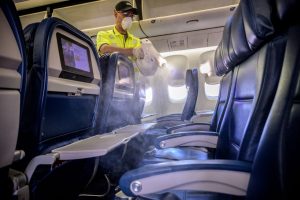Launch of the aviation health security protocol against COVID
Health and hygiene, new paradigms of aviation safety
The European Union Aviation Safety Agency (EASA) and the European Center for Disease Prevention and Control (ECDC) have issued an Aviation Health Safety Protocol on behalf of the European Commission (EC), which defines measures to ensure the safety of the health of air passengers and flight personnel, once airlines resume their regular hours of operation after the unprecedented industry disruption caused by the COVID-19 pandemic.
The guidelines place paramount importance on health safety at every stage of the end-to-end passenger journey. Recognizing that airports, airlines, and aircraft are different, the implementation takes a pragmatic approach: it highlights and provides guidance on how individual locations and situations can be better redesigned to meet new health safety standards.
The protocol, although specific to commercial aviation, logically includes some general principles at all times: observe physical distance whenever possible, use a medical mask to protect other passengers and scrupulous and frequent hand hygiene. Air passengers and the general population must be certain that the filtered air in airplanes is safer and cleaner than that breathed on the ground.
“Passenger and crew safety has always been paramount in aviation,” said European Transport Commissioner Adina Valean. “Passengers must have the confidence that flying back to heaven in a closed space with other people represents the least possible risk to their health. We rely on our EASA and ECDC specialists to define a set of concrete measures for the safe resumption of air travel within the EU. ”
 Photo: hostelsur
Photo: hostelsur
Measures from start to finish
The guide examines each phase of the passenger’s journey and specifies the actions to be taken or the measures implemented in six segments of the journey: before arriving at the airport, at the departure terminal, when boarding, in flight, in transit and on Arrival to the final destination. A separate section focuses on the safety of flight crew members.
“Ensuring health safety is a critical factor for the resumption of commercial air travel,” said EASA CEO Patrick Ky, added:
“This protocol is the model for a safe air trip for the passenger, from the moment of arrival at the departure airport until the departure at the destination airport.”
Ky also stressed that this is the beginning, rather than the end, of a process to make air travel as safe as possible from a health perspective, in addition to technical safety, which until now has been the primary focus of EASA. “The next task is for airlines and airport operators to tailor the guidelines to their individual facilities and operations.
ECDC Director Andrea Ammon said: “This joint work will provide a source of best practice on how airport operators, airlines and national aviation authorities can reduce the risk of virus transmission for passengers, as well as for the staff and crew serving them while maintaining safety and safe operations. ”
The guidelines are based on the scientific experience of both agencies and reflect the best available scientific knowledge currently available. The ECDC continually monitors the status of COVID-19 and will update the guidelines as new epidemiological reporting, testing and treatment modalities become available.
Passengers themselves are also expected to take on a personal responsibility: passengers who have symptoms compatible with COVID-19 (fever, cough, sudden loss of smell, difficulty breathing) or who know that they have been in contact with a case of COVID- 19 must not arrive at the airport or must postpone their trip to protect their fellow travelers.
Passengers are advised to practice distancing, hand hygiene, respiratory etiquette, and to wear medical face masks, and to declare their COVID-19 related status before receiving their boarding pass. Passengers will also be asked to provide contact information to allow “track and trace” if someone on a particular flight then tests positive for COVID-19.
Those who do not travel must say goodbye to the passenger before entering the terminal building, except in defined special cases.

Thanks HostelSur
Airlines and airports
From airlines and airports, they will require significant changes in their processes. The protocol states: “aircraft operators and airport operators must cooperate to ensure that physical distance is respected whenever possible, especially during check-in, security screening, pre-boarding, and boarding. When the recommended physical distance of 1.5 meters is not possible, due to infrastructure or operational limitations, aircraft operators and airport operators should implement additional risk mitigation measures, such as hand hygiene, use of face masks, transportation additional etc. ”
On the aircraft, the guidelines offer some flexibility due to limited space. “In addition to the other health and hygiene measures that must be observed at all times, when the passenger allows it, as well as the cabin configuration and mass and balance requirements, aircraft operators must guarantee, to the extent possible, the physical distance between the passengers. ”
These recommended measures will be periodically evaluated and updated according to changes in knowledge of the risk of transmission, as well as the development of other diagnostic or preventive measures (including technological ones) and the evolution of the pandemic.
Source: Hostelsur






No Comments